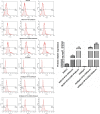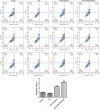IP10-CDR3 Reduces The Viability And Induces The Apoptosis Of Ovarian Cancer Cells By Down-Regulating The Expression Of Bcl-2 And Caspase 3
- PMID: 32009802
- PMCID: PMC6859960
- DOI: 10.2147/OTT.S209757
IP10-CDR3 Reduces The Viability And Induces The Apoptosis Of Ovarian Cancer Cells By Down-Regulating The Expression Of Bcl-2 And Caspase 3
Abstract
Purpose: This study aimed to explore the effects of interferon-γ inducible protein 10 (IP10) and complementarity-determining region 3 (CDR3) of T cells receptor on ovarian cancer cells and the involved mechanisms.
Methods: IP10 and CDR3 were linked with single-chain antibody (scfv) and exotoxin gene muton of Pseudomonas aeruginosa (PE40) to construct IP10-CDR3scfv and IP10-CDR3-PE40scfv. Then, we constructed pcDNA3.1-IP10-CDR3scfv and pcDNA3.1-IP10-CDR3-PE40scfv plasmids which were proved by HindIII/EcoRI digestion. SKOV3 cells and HOSEpiC cells were incubated with fluorescein isothiocyanate (FITC) labeled IP10-CDR3scfv and IP10-CDR3-PE40scfv proteins and protein levels were examined by flow cytometry. After gene transfection, SKOV3 cells were divided into four groups: Control, pcDNA3.1(+) negative control (NC) (pcDNA3.1(+) NC transfection), IP10-CDR3scfv (IP10-CDR3scfv transfection) and IP10-CDR3-PE40scfv (IP10-CDR3-PE40scfv transfection). Levels of IP10, CDR3, Caspase-3, cleaved Caspase-3 and Bcl-2 were determined by RT-PCR and Western blot. Cell viability and apoptosis were investigated by CCK-8 assay and Annexin V-FITC/PI assay, respectively.
Results: The levels of FITC-labeled IP10-CDR3scfv and IP10-CDR3-PE40scfv proteins in the SKOV3+IP10-CDR3scfv group and the SKOV3+IP10-CDR3-PE40scfv group were remarkably higher than that in the SKOV3 group (P<0.05). So was the HOSEpiC related groups. There was no obvious difference in the levels of IP10, CDR3, Caspase-3, cleaved Caspase-3 and Bcl-2 between the control group and the pcDNA3.1(+) NC group. However, compared with the control group, the levels of Caspase-3 and Bcl-2 were reduced notably and the levels of IP10, CDR3 and cleaved Caspase-3 were elevated sharply in the IP10-CDR3scfv and IP10-CDR3-PE40scfv groups (P<0.05). The control group and the pcDNA3.1(+) NC group demonstrated similar cell viability and apoptosis. However, compared with the control group, cell viability in the IP10-CDR3scfv and IP10-CDR3-PE40scfv groups decreased significantly and cell apoptosis increased (P<0.05).
Conclusion: IP10-CDR3 could reduce the viability and induce the apoptosis of ovarian cancer cells by down-regulating the expression of Bcl-2 and Caspase-3.
Keywords: Bcl-2; CDR3; Caspase-3; IP10; cell apoptosis; ovarian cancer.
© 2019 Chen et al.
Conflict of interest statement
The authors report no conflicts of interest in this work.
Figures






Similar articles
-
[Effect of MTRR gene on apoptosis and autophagy pathways in multiresistant epithelial ovarian cancer].Zhonghua Fu Chan Ke Za Zhi. 2016 Apr 25;51(4):285-92. doi: 10.3760/cma.j.issn.0529-567X.2016.04.008. Zhonghua Fu Chan Ke Za Zhi. 2016. PMID: 27116987 Chinese.
-
[Growth inhibitory effects of THY1 gene on epithelial ovarian cancer SKOV3 cells].Nan Fang Yi Ke Da Xue Xue Bao. 2007 Jan;27(1):84-7, 91. Nan Fang Yi Ke Da Xue Xue Bao. 2007. PMID: 17259155 Chinese.
-
[Tanshinone IIA inhibits hypoxia/reoxygenation-induced cardiomyocyte apoptosis and autophagy by regulating ABCE1].Zhonghua Wei Zhong Bing Ji Jiu Yi Xue. 2023 Jun;35(6):627-632. doi: 10.3760/cma.j.cn121430-20230210-00082. Zhonghua Wei Zhong Bing Ji Jiu Yi Xue. 2023. PMID: 37366130 Chinese.
-
[Effects of miR-135a on HOXA10 expression, proliferation and apoptosis of ovarian cancer cells].Zhonghua Fu Chan Ke Za Zhi. 2013 May;48(5):364-9. Zhonghua Fu Chan Ke Za Zhi. 2013. PMID: 24016480 Chinese.
-
[The role and mechanism of human trophoblastic cell surface antigen 2 in the invasion and metastasis of ovarian cancer].Zhonghua Zhong Liu Za Zhi. 2021 Mar 23;43(3):299-305. doi: 10.3760/cma.j.cn112152-20200408-00322. Zhonghua Zhong Liu Za Zhi. 2021. PMID: 33752309 Chinese.
Cited by
-
STING directly interacts with PAR to promote apoptosis upon acute ionizing radiation-mediated DNA damage.Cell Death Differ. 2025 Jun;32(6):1167-1179. doi: 10.1038/s41418-025-01457-z. Epub 2025 Feb 12. Cell Death Differ. 2025. PMID: 39939798 Free PMC article.
-
Molecular Mechanisms of Cassia fistula against Epithelial Ovarian Cancer Using Network Pharmacology and Molecular Docking Approaches.Pharmaceutics. 2022 Sep 19;14(9):1970. doi: 10.3390/pharmaceutics14091970. Pharmaceutics. 2022. PMID: 36145718 Free PMC article.
-
High Expression of Interferon Pathway Genes CXCL10 and STAT2 Is Associated with Activated T-Cell Signature and Better Outcome of Oral Cancer Patients.J Pers Med. 2022 Jan 21;12(2):140. doi: 10.3390/jpm12020140. J Pers Med. 2022. PMID: 35207629 Free PMC article.
-
In Vivo Effects of Conditioned Medium from Human Uterine Cervical Stem Cells in an Ovarian Cancer Xenograft Mouse Model.Cancer Genomics Proteomics. 2022 Sep-Oct;19(5):570-575. doi: 10.21873/cgp.20341. Cancer Genomics Proteomics. 2022. PMID: 35985689 Free PMC article.
References
-
- Qin M, Jin Y, Ma L, et al. The role of neoadjuvant chemotherapy followed by interval debulking surgery in advanced ovarian cancer: a systematic review and meta-analysis of randomized controlled trials and observational studies. Oncotarget. 2018;9:8614–8628. doi:10.18632/oncotarget.v9i9 - DOI - PMC - PubMed
LinkOut - more resources
Full Text Sources
Research Materials
Miscellaneous

